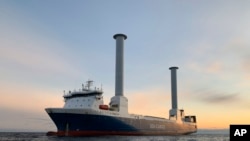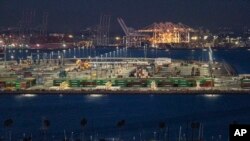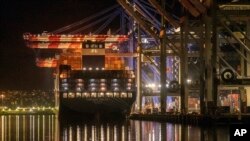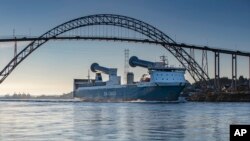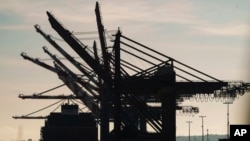It's among the world's busiest container shipping routes — a stream of vessels packed with furniture, automobiles, clothing and other goods, traversing the Pacific between Los Angeles and Shanghai.
If plans succeed, this corridor will become a showcase for slashing planet-warming carbon emissions from the shipping industry, which produces nearly 3% of the world's total. That's less than from cars, trucks, rail or aviation but still a lot — and it's rising.
The International Maritime Organization, which regulates commercial shipping, wants to halve its greenhouse gas releases by midcentury and may seek deeper cuts this year. “Shipping must embrace decarbonization," IMO Secretary-General Kitack Lim said in February.
Meeting agency targets will require significant vessel and infrastructure changes. That's inspiring plans for “green shipping corridors" along major routes where new technologies and methods could be fast-tracked and scaled up.
More than 20 of these partnerships have been proposed. They're largely on paper now but are expected to take shape in the coming years.
Front-runners
Los Angeles and Shanghai formed their partnership last year.
“The vision is that a container will leave a factory on a zero-emissions truck (in China)," said Gene Seroka, executive director of the Port of Los Angeles.
“It will arrive at the port of Shanghai, be loaded onto a ship by a zero-emissions cargo handling equipment unit and move across the Pacific Ocean on a vessel that emits zero carbon. Once it gets to Los Angeles, the reverse happens," with carbon-free handling and distribution.
Los Angeles entered a second agreement in April with nearby Long Beach and Singapore. Others in the works include the Great Lakes-St. Lawrence River; a Chilean network; and numerous corridors in Asia, North America and Europe.
C40 Cities, a global climate action coalition of mayors, advocates green corridors as "tools that can turn ambition into action, bringing together the entire shipping value chain,” said Alisa Kreynes, a deputy director.
Pressure builds
From tea to tennis shoes, stuff in your pantry and closets likely spent time on a ship.
Roughly 90% of traded goods move on water, some in behemoths longer than four football fields, each holding thousands of containers with consumer products. About 58,000 commercial ships ply the seas.
Their emissions are less noticeable than onshore haulers such as trucks, although noxious fumes from ships draw complaints in port communities.
Maritime trade volumes are expected to triple by 2050, according to the Organization for Economic Cooperation and Development. Studies predict the industry's share of greenhouse gas emissions could reach 15%.
Yet the 2015 Paris climate accord exempts maritime shipping, partly because vessels do business worldwide, while the agreement covers nation-by-nation goals.
“No one wants to take responsibility,” said Allyson Browne of Pacific Environment, an advocacy group. “A ship may be flagged in China, but who takes ownership of emissions from that ship when it’s transporting goods to the U.S.?”
The IMO responded to mounting pressure with a 2018 plan for a 50% emissions reduction by midcentury from 2008 levels. An update scheduled for July may set more ambitious targets favored by the U.S., Europe and small island nations. Opponents include Brazil, China and India.
The Biden administration wants a zero-emission goal, a State Department official told The Associated Press.
But fewer than half of large shipping companies have pledged to meet international carbon objectives. And there's no consensus about how to accomplish them.
“Global shipping is hard to decarbonize ... because of the energy required to cover long distances with heavy cargoes,” said Lee Kindberg, head of environment and sustainability for Maersk North America.
Mechanical sails. Batteries. Low- or zero-carbon liquid fuels.
They're among propulsion methods touted as replacements for “bunker fuel” that powers most commercial ships — thick residue from oil refining. It spews greenhouse gases and pollutants that endanger human health: sulfur dioxide, nitrogen oxide, soot.
Finding alternatives will be a priority for green shipping corridors.
For now, liquid natural gas is the runaway choice. Worldwide, it's used by 923 of 1,349 commercial vessels not powered by conventional fuels, according to a study last year by DNV, a Norway-based maritime accreditation society. Vessels with batteries or hybrid systems placed a distant second.
Many environmentalists oppose LNG because it emits methane, another potent greenhouse gas. Defenders say it's the quickest and most cost-effective bunker fuel substitute.
Of 1,046 alternative-energy ships on order, 534 are powered by LNG while 417 are battery-hybrids, DNV reported. Thirty-five others will use methanol, which analysts consider an up-and-coming cleaner alternative.
Moller-Maersk plans to launch 12 cargo vessels next year that will use “green methanol" produced with renewable sources such as plant waste.
Norsepower offers a new twist on an ancient technology: wind.
The Finnish company has developed “rotor sails” — composite cylinders about 33 yards (30 meters) tall that are fitted on ship decks and spin in the breeze. Air pressure differences on opposite sides of the whirring devices help push a vessel forward.
An independent analysis found rotor sails installed on a Maersk oil tanker in 2018 produced an 8.2% fuel savings in a year. Norsepower CEO Tuomas Riski said others have saved 5% to 25%, depending on wind conditions, ship type and other factors.
Thirteen ships are using the devices or have them on order, Riski said.
“Mechanical sails have an essential role in the decarbonization of shipping,” he said. “They can't do it alone, but they can make a great contribution.”
Who goes first?
Before building or buying low-emission vessels, companies want assurances clean fuels will be available and affordable.
Companies producing the fuels, meanwhile, want enough ships using them to guarantee strong markets.
And both need port infrastructure that accommodates new-generation ships, such as electrical hookups and clean fuel dispensing mechanisms.
But ports await demand to justify such expensive upgrades. Switching onshore cargo handling equipment and trucks to zero-emission models will cost the Los Angeles port $20 billion, officials say.
“Once you put a (green) corridor on the map,” said Jason Anderson, senior program director for the nonprofit ClimateWorks Foundation, “at least they’re heading in the same direction.”




